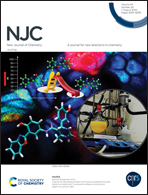Two isostructural Ln3+-based heterometallic MOFs for the detection of nitro-aromatics and Cr2O72−†
Abstract
Luminescent MOFs (LMOFs) are increasingly regarded as potential chemical sensors with the advantages of high sensitivity and selectivity for detecting various analytes. Here, two isostructural Ln3+-based heterometallic MOFs (In/Eu-CBDA and In/Tb-CBDA) based on the tetracarboxylic acid ligand [CBDA = 5,5′-(carbonylbis(azanediyl))-diisophthalic acid] have been successfully synthesized. According to the hard and soft acid–base (HSAB) theory, the compounds exhibit excellent stability, which is conducive to the application of practical properties. Therefore, In/Eu-CBDA and In/Tb-CBDA were used in the detection of nitro-aromatics and anions. The results showed that they have the ability to detect 1,4-dinitrobenzene and Cr2O72− with high selectivity and sensitivity. In particular, Cr2O72− on In/Tb-CBDA is detected with a quenching constant of 1.72 × 104 M−1 and a detection limit of 8.72 × 10−6 M−1 in the water environment, which shows that it can be used as a promising candidate luminescent sensor for application in the detection of Cr2O72− in wastewater.



 Please wait while we load your content...
Please wait while we load your content...